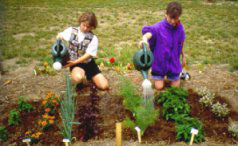Amount of land needed: Two children are assigned to each garden plot of about 8 feet × 12 feet. Garden space needed for 20 participants will be a minimum of 80 feet x 200 feet. Often a border of annual flowers is nice to enclose the entire garden plot. You may also wish to separate each garden plot with a 2- or 3-foot border so children are not stepping on other's plants. Additional space is nice to grow large vining crops or to construct teepees with runner beans growing on them or a simple trellis for squash.

Location to youth: The garden site should be within walking or biking distance of the youths' homes. Many parents can not transport their children twice a week to an activity if they are working. Because of liability problems, we cannot accept the responsibility of transporting children. However, parents may be encouraged to set up carpools to transport their children.
Access to water: Water at the garden site is essential! All vegetable gardens will need to be watered during the summer. Kids do not enjoy hauling water from another site or watching their plants die due to lack of moisture. Consider locating the garden as close to the water source as possible (within 50 feet) to minimize the length of hoses needed to water the gardens.
Amount of sun: Vegetables require full sun for optimum growth. Be sure that trees do not shade the garden during the day.
Who owns the land? If the land is owned by a church, school, home or private owner, this may be fine for your project. However, permission to use the land for the Garden 'n Grow program should be obtained in writing.
Present use of the land: Ask neighbors about the lot's history. If cars are parked on the lot, or drugs are sold there, it's likely that this will continue to be an unsafe environment for the children.
Water drainage: Sites that have heavy clay soil are often waterlogged after heavy rainfall or irrigation because of poor drainage. Also, sites with low spots often have poor water drainage. Root rot and other diseases that are prevalent in poorly drained soils will result in poor plant growth. In these situations, it would be best to select a different site to ensure the success of the gardens.
Soil conditions: Soil tests should be conducted at least four months before planting. Contact your local MU Extension office for instructions on how to obtain a good soil test. Often Missouri soils are deficient in phosphorus or may require lime to raise the soil pH.